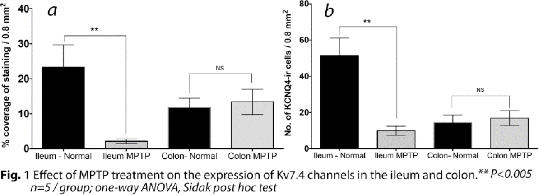Print version
Search Pub Med
| 219P London, UK Pharmacology 2017 |
Loss of KCNQ4 encoded K+ channel (Kv7.4) protein in the gastrointestinal tract of MPTP treated primate model of Parkinson’s disease
Introduction: Gastrointestinal (GI) dysfunction is a common non-motor feature of Parkinson’s disease (PD) which may result from the aberrant contractile response of the GI smooth muscle1. Activation or inhibition of K+ channels hyperpolarize or depolarize cell membrane, which determines decrease or increase in Ca2+ influx through voltage-gated Ca2+ channels, resulting in the relaxation or contraction of the GI smooth muscle. Recent studies highlight the importance of KV7.4 channels in regulating gastrointestinal smooth muscle tone and contractility2, therefore our aim was to investigate whether Kv7.4 channels are likely to be involved in GI dysfunction in a relevant model of PD.
Method: Paraformaldehyde-fixed, paraffin-embedded, 8 μm transverse sections of ileum and colon from drug naïve (n=5; 3 female and 2 male, weight: 366-444g) and 1-methyl-4-phenyl-1,2,3,6-tetrahydropyridine (MPTP)-treated common marmosets (Calithrix jacchus; n=5; 3 female and 2 male; weight: 348-480g; MPTP: 2 mg/kg administered for 5 consecutive days3) were processed for peroxidase avidin-biotin immunohistochemistry using an anti-KCNQ4 antibody (AbCam, ab65797). Sections of appropriate regions were photographed and the number of immunoreactive (-ir) cells, % area of immune-coverage and staining intensity was quantified using ImageJ.
Results: Numerous KCNQ4-ir cellular structures were observed, expressed as punctate cellular structures within the longitudinal muscle and in the mucosa, while in the circular muscle layer immunoreactivity was localised to elongated cellular structures. Overall, there was a marked reduction in KCNQ-ir in the longitudinal muscle layer of the ileum following MPTP treatment, but the colon was unaffected (Fig 1a). The mean number of punctate KCNQ4-ir cellular structures within the longitudinal muscle were markedly reduced in the ileum but not in the colon of the MPTP-treated animals (Fig 1b).

Conclusions: This data shows that MPTP treatment of common marmosets significantly reduced the expression of KV7.4 channels in the ileum but not in the colon. The reason for this is not clear but indicates a potential mechanism of the impairment of the smooth muscle contractile / relaxant responses commonly observed in the GI dysfunction of PD.
References:
1) Barone P et al.(2009) Mov. Dis. 24: 1641-1649.
2) Barrese V et al. (2017) Annu Rev Pharmacol Toxicol. doi: 10.1146/annurev-pharmtox-010617-052912
3) Iravani MM et al. (2006) J Neurochem. 96: 1315-21.

